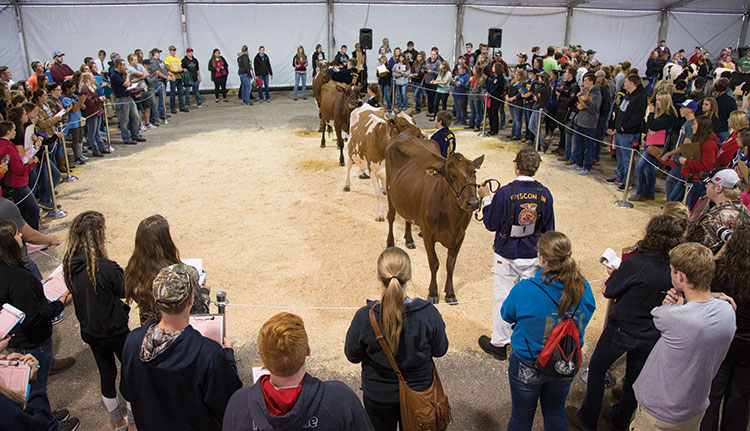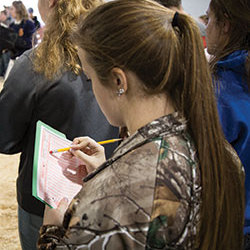
In addition, many schools bring along other students to tour the grounds while their classmates compete in the dairy cattle evaluation, showmanship, dairy products judging, and World Forage Management Cup contests. In all, close to 3,000 students visit World Dairy Expo each year on that first day of the show.
Mark Zidon, a professor at the University of Wisconsin-Platteville, serves as superintendent of the dairy evaluation contest. He is also the overall superintendent for the four competitions. This marks the 28th year he has overseen these educational events.
He said that the World Dairy Expo staff is very supportive of the FFA’s presence at the show. “They love to see students there,” he noted.

Judging some of the best
Dairy cattle judging is the largest of the four contests, with 400 participants last year. For young dairy cattle judges, the opportunity to evaluate some of the best cattle in the nation is a thrill.
The dairy cattle contest takes place in the sale pavilion tent. It consists of four classes of cows or heifers from a variety of breeds and one set of questions. Due to time limitations and the large number of students, no oral reasons are given.
With such growth in participation, the contest is now offered in two heats to better accommodate the young judges. Simultaneously, a showmanship contest is taking place with 16 individuals in each heat.
Zidon works with Jason James, a dairy producer from Mineral Point, Wis., to select the classes. Jeff Dornink from Southwest Wisconsin Technical College and his wife, Lynette, determine the official placings and judge showmanship. Zidon appreciates the support of these volunteers. “I couldn’t do it without their help,” he said. In addition, students from the University of Wisconsin-Platteville serve as group leaders and assist at the various contests.
Drawn to the competition
The dairy products judging contest takes place across the street at the Sheraton Madison Hotel. These students assess, identify, and score milk, cheese, and other dairy products. The contest consists of five sections: a written exam about the dairy industry; identifying seven to 10 cheeses; evaluating eight to 10 milk flavor samples; identifying six to 10 characteristics for cheese; and evaluating five to 10 fat content products. This contest also takes place in two heats.
Also held at the hotel is the World Forage Management Cup contest. This contest consists of three parts. One is the judging of six different rings of hay or silage. Each ring has four different samples that must be ranked.
The next section includes the identification of 60 plants and seeds of crops used for forage and weeds that compete with forage crops. There is also a forage management test with 60 multiple choice questions.
Each of these contests is run by a superintendent and volunteers as well. Approximately 250 students participate in the dairy products contest while 180 judge in the World Forage Management Cup.
“The contests have grown a lot over the years,” noted Zidon. Participation has doubled since he took over as superintendent in the 1990s. Many of the FFA chapters represented are from Wisconsin, Illinois, Iowa, and Minnesota, but teams from Indiana, Ohio, Colorado, and even California travel to participate.
Zidon pointed out that some teams use the World Dairy Expo contests as a practice for the national FFA contests that take place about a month later at National FFA Convention. In addition, for the dairy judges, they get the opportunity to see a lot of high-quality cattle in one place. “It’s a really good experience and a really good workout for them,” Zidon said.
Beyond the contests
While some students are judging, others are exploring the trade show. While students may not be a company’s target audience, that doesn’t mean there isn’t value in catering to these younger guests. There’s no way to predict which of these students will become a future customer or employee.
One company that has stepped up in support of the FFA members is FutureCow. According to FutureCow’s Angelina Bertino, one year they held a raffle for students during Expo. The prize was a show calf provided by one of their customers, Siemers Holsteins from Newton, Wis.
In other years, they have done a drawing for the official FFA boots by Durango. Students who came by the booth and dropped off their entry ticket were entered into the drawing. Ten winners were drawn at the end of the show.
Bertino explained that Durango has come on board with their support and now donates the boots. Winners are given a code so that they can go online and pick the color and size they want, and Durango ships them directly to the students.
“We, including the generous people who help us, such as Durango, believe the FFA members are the farmers of tomorrow,” Bertino said. “It is very important to us that they know they are appreciated and encouraged to fulfill their dream of being a dairy farmer.”
Lely North America takes a similar approach.
“We intentionally plan specific youth activities on the first day of Expo,” said Bellana Putz, customer sales support manager. The reasons they do this are two-fold.
“All kids are consumers,” Putz noted, “and we want them to continue buying dairy products. This is also an opportunity for education and to talk to them about the dairy industry.”
Agriculture is very diverse with many career opportunities, but Putz explained, “Some youth may not have mentors or may not have had their windows opened to see all these opportunities. We want to help explain career opportunities in agriculture so they can find a fit for themselves.”
To help with that process, last year Lely purposefully manned their booth on Tuesday with some of their new hires and past interns. They set up an area where FFA members could sit in the audience and moderated a discussion with a Q&A session. “We encouraged them to ask questions of these young employees and interns because they are going to be in their shoes very soon,” Putz said. The panel was well received and some students came up after and asked more questions.
Another year, Lely put up a sign to collect signatures of FFA and 4-H members. For every signature, they pledged to donate $1 to FFA and 4-H. “That sign was jam packed, with no white space left,” Putz said. “It was a fun way to get them to visit our booth.” Planning activities for the youth attendees is part of their preparation for World Dairy Expo every year, Putz explained.
Other exhibitors accommodate younger visitors as well. In previous years, workshops were also held during the day geared toward students. And, of course, some youth like to take a look at the cattle in the barns. “The chance to get young students involved in the show is a real plus,” said Zidon.
Whatever they do to fill their time at World Dairy Expo is valuable, and visits like this give students an opportunity to dip their toes in the dairy industry water.











